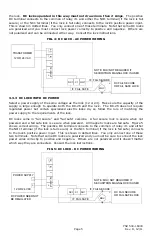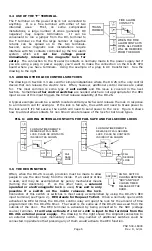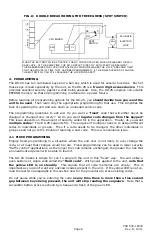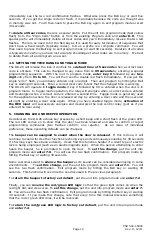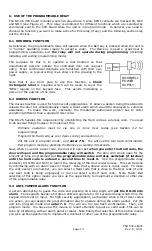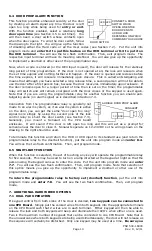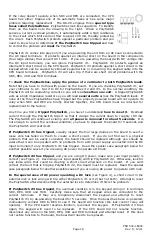
PN# 500-16900
Page 19
Rev. D, 12/11
PROBLEM-- Keys do not operate but a beep is heard every five seconds
This is a diagnostic feature which indicates that one of the keys is being read as down (always
being pressed). In that condition, the CPU board will not be able to read any other keys. It can
happen because of mechanical failure within the switch element such that the key really is down,
or keypad wires that are shorted to each other. The latter problem usually happens when
insulation is scraped off some of the wires in the keypad cable as it’s being pulled through the
door frame. You may be able to restore operation by rapping on all the keys. If this works,
however, it is likely only a temporary fix and you should be prepared to change the keypad.
Next, check the wiring of the keypad cable into the board (see Figure 2). If you don’t see any
problems, the keypad will need to be replaced but you can restore partial use, if you wish, while
awaiting a replacement. Put the positive probe of a voltmeter on terminal WHT and successively
apply the negative probe on terminals BLK, GRY, BRN, BGE, ORG, PNK, and VIO. “Good”
terminals will read about 11 volts. Two terminals, however, will read about zero volts. Remove
the wires from the two terminals which read zero volts. If you are wondering why a single down
key does not create a single zero volt terminal read, you should understand that the keys are in
a two of seven matrix so the one to one relationship doesn’t hold. When you remove the two
wires from the zero volt reading terminals, you will disable several keys. You will be able to
determine which keys are working by pressing each key and seeing which ones are echoed by a
beep and LED flash. You can then establish a temporary Hard code using only the active keys
by pressing the Hard Code button on the CPU board and following the instructions in Section 4.1.
PROBLEM-- A key isn’t echoed (no beep or LED flash)
This is the opposite of the above problem. A key is failing to be read when it is pressed. This
can happen because of mechanical failure within the switch element such that the key will not
close, or from a broken or mis-wired keypad wire. If, however, the problem is with a wire, more
than one key will be “dead”. If just one key is not being echoed, the problem is with the key
itself. You can, of course, use the unit for all operations that don’t require that particular key
but you will want to replace the keypad for full operation.
PROBLEM-- Unit beeps when keys are pressed but does not accept programming
If the problem occurs on initial installation, usually it's caused by misunderstanding the
programming instructions. Read them again carefully. Be sure you're not waiting more than 5
seconds between hitting keys as if you are, the entry will be ignored. Finally note that if
terminals SRC and UCD are connected, all User codes will be disabled. If terminals SRC and
HCD are connected, the Hard code will be disabled.
PROBLEM-- Beeper doesn’t sound while the unit otherwise functions
Note that the beeper could have been deliberately silenced by the unit having been sent a
special command. Even on a new unit, this could have happened by factory error. Attempt to
restore the beeper by putting the unit into program mode and entering 7-2. You should see the
two red flash confirmation. If the beeper still doesn’t work, the problem is either a wiring
mistake, a defective beeper or a fault on the CPU board with the output that drives the beeper.
Check that the keypad blue wire (this controls the beeper) is connected into terminal BLU. If it
is, next remove it from the BLU terminal and briefly touch it to terminal DC-. If the beeper
sounds, the problem is with the beeper driver on the CPU board and the CPU board will have to
be replaced. If the beeper does not sound, the problem is with the beeper itself in the keypad or
with the internal beeper wiring within the keypad. The beeper is the only part of the keypad
which is repairable. This is because the beeper is physically located in a chamber at the bottom
of the keypad. If it was sealed in the keypad, the sound level would not be adequate. Look at
the beeper in its chamber to confirm that the wires look OK. You can then return the keypad to
the factory for beeper replacement or you can replace the beeper in the field (this requires
soldering). The part number for a replacement beeper from Securitron is 050-10600.
PROBLEM-- One or more of the LED’s do not work while the unit otherwise functions
This is either a wiring mistake, a failed LED in the keypad or a fault on the CPU board with the
output that drives the LED. Each LED is operated by the wire that bears the LED’s color. So, for
example, if the green LED is the one that is not working, first check to see that the green
keypad wire is correctly connected to terminal GRN. . If it is, next remove it from the GRN
terminal and briefly touch it to terminal DC-. If the green LED comes on, the problem is with
the driver on the CPU board and the CPU board will have to be replaced. If the LED does not
Summary of Contents for Securitron DK-26
Page 23: ......

